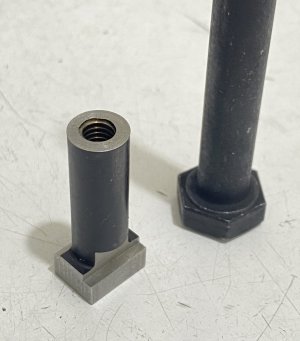I tried the other day to make the part ( a special T nut ) on the left side of the photo from M10 12.9 HT bolts the and quite some difficulty was encountered :
1) work hardening ! The parting tool was carbide and I need to be very determined in feeding the tool or the surface will become so hard and so quickly that the tool wouldn't cut no matter how large the feeding force was. I used to believe 304 stainless steel is the worst in this regard but this material is clearly much more stubborn.
2) Not really an issue but when I retract the drill bit from the hole ( 5 mm ), some significant resistance was felt. It appears that either the hole is not straight or the diameter is smaller than that of the drill ?
3) This is major. I tapped the hole with an HSS M6 tap and after going in for about 10 mm, the tap couldn't be turned any further. Not sure what the cause is. Should I use drills of larger diameters ?
Repeated on 8.8 grade HT bolts. No joy.
Then I tried the same operations on softer mild steel stock ( 1018 I believe ) using the same tools and no problems were encountered.
Is this machining difficulties expected for HT bolts ?
1) work hardening ! The parting tool was carbide and I need to be very determined in feeding the tool or the surface will become so hard and so quickly that the tool wouldn't cut no matter how large the feeding force was. I used to believe 304 stainless steel is the worst in this regard but this material is clearly much more stubborn.
2) Not really an issue but when I retract the drill bit from the hole ( 5 mm ), some significant resistance was felt. It appears that either the hole is not straight or the diameter is smaller than that of the drill ?
3) This is major. I tapped the hole with an HSS M6 tap and after going in for about 10 mm, the tap couldn't be turned any further. Not sure what the cause is. Should I use drills of larger diameters ?
Repeated on 8.8 grade HT bolts. No joy.
Then I tried the same operations on softer mild steel stock ( 1018 I believe ) using the same tools and no problems were encountered.
Is this machining difficulties expected for HT bolts ?
Attachments
Last edited:


